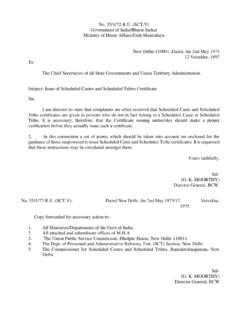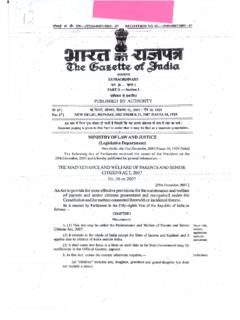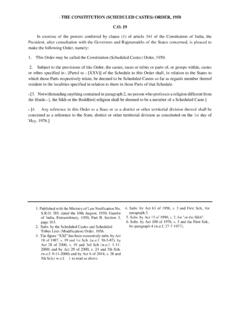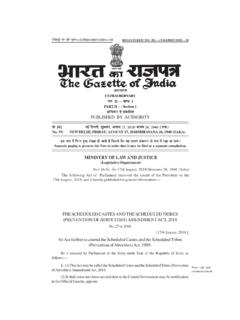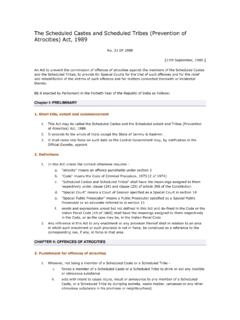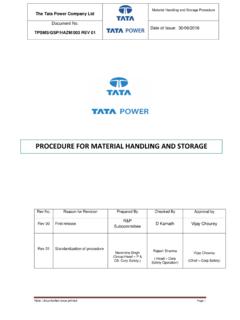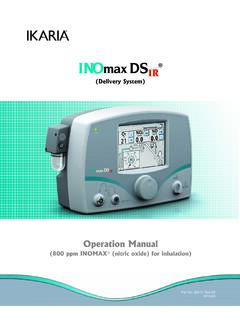Transcription of Govt. of India Ministry of Social Justice and Empowerment ...
1 SCHEME OF ASSISTANCE TO DISABLED PERSONS FOR PURCHASE/FITTING OF AIDS/APPLIANCES (ADIP SCHEME) Applicable April, 2005 Govt. of India Ministry of Social Justice and Empowerment , Shastri Bhawan New Delhi SCHEME OF ASSISTANCE TO DISABLED PERSONS FOR PURCHASE/FITTING OF AIDS/APPLIANCES (ADIP SCHEME) 1. INTRODUCTION It has been the constant endeavour of the Government to provide the disabled persons with aids/appliance at minimum costs. The requirement for providing of aids/appliances, which are essential for the Social , economic and vocational rehabilitation of the disabled persons, has come into sharp focus, particularly after the enactment of the Persons with Disabilities (Equal Opportunities, Protection of Rights and Full Participation) Act, 1995, which came into force in 1996. Various surveys conducted from time to time have made it clear that India has a very large number of disabled persons.
2 Many of them come from low-income groups. Disability restricts their opportunities for leading functionally productive lives. From the application of modern technology, there have emerged a number of aids, which can reduce the effects of disabilities and enhance the economic potential of the disabled. To illustrate a wheel chair, an artificial limb, crutch, a brace, a splint can greatly improve the mobility of physically disabled individual. Similarly, with the help of a powerful hearing aid, persons with some residual hearing can be helped to carry on many activities of daily living. Low vision to read, print and undertake other activities resulting in their rehabilitation. However, a large number of disabled persons are deprived of the benefits of these appliances because of their inability to find funds to purchase them.
3 In the light of the Government s growing stress on helping disabled persons and in bringing the aids and appliances within their reach, it has been decided to continue the ADIP Scheme and modify it in such a way that it becomes more user-friendly and the needy are not deprived of aids/appliances, which are essential for their Social , economic and vocational rehabilitation. If they can, thereby, become earning members they would be much closer to achieve economic self-dependence and also be able to live and pursue their activities dignity. 2. THE SCHEME AND ITS OBJECTIVES The Scheme aims at helping the disabled persons by bringing suitable, durable, scientifically-manufactured, modern, standard aids and appliances within their reach. The estimates, according to 58th Sample Survey conducted by NSSO in 2002, indicate that there are million persons with various types of disabilities in the country.
4 Their disabilities restrict the opportunity for their economic and Social growth. In addition, about 3 % of the children below 14 years of age suffer from delayed development. Many of them are mentally retarded and cerebral palsied and require some aids/appliances to attain the capacity for self-care and independent living. The main objective of the Scheme is to assist the needy disabled persons in procuring durable, sophisticated and scientifically manufactured, modern, standard aids and appliances that can promote their physical, Social and psychological rehabilitation, by reducing the effects of disabilities and enhance their economic potential. The aids and appliances supplied under the Scheme must be ISI. 3. DEFINITIONS Definitions of various types of disabilities as given in The Persons with Disabilities (Equal Opportunities, Protection of Rights and Full Participation) Act, 1995 (PWD ACT).
5 4. SCOPE The Scheme will be implemented through the Implementing Agencies as listed in the following para. The Agencies will be provided with financial assistance for purchase, fabrication and distribution of such standard aids and appliances that are in conformity with objective of the Scheme. The Implementing Agencies will take care of/make suitable arrangements for fitting and post-fitting care of the aids and appliances distributed under ADIP Scheme. The scope of the Scheme has been further enlarged to include use of mass media, exhibitions, workshops etc. for exchange of information and promoting awareness and distribution and use of aids/appliances. The Scheme shall also include under its ambit, medical/surgical correction & intervention, which is essential prior to fitment of aids and appliances. The cost could range from Rs. 500/- for hearing & speech impaired to Rs. 1,000/- for visually disabled and Rs.
6 3,000/-for Orthopaedically disabled. 5. ELIGIBILITY OF IMPLEMENTING AGENCY UNDER THE SCHEME The following agencies would be eligible to implement the Scheme on behalf of Ministry of Social Justice and Empowerment , subject to fulfillment of laid down terms and conditions: i) Societies, registered under the Societies Registration Act, 1860 and their branches, if any, separately. ii) Registered charitable trusts iii) District Rural Development Agencies, Indian Red Cross Societies and other Autonomous Bodies headed by District Collector/Chief Executive Officer/District Development Officer of Zilla Parishad. iv) National/Apex Institutes including ALIMCO functioning under administrative control of the Ministry of Social Justice and Empowerment / Ministry of Health and Family Welfare. v) State Handicapped Development Corporations. vi) Local Bodies- Zilla Parishad, Municipalities, District Autonomous Development Councils and Panchayats.
7 Vii) Nehru Yuvak Kendras. Grant-in-aid under the Scheme will not be given for commercial supply of aids/appliances. The NGOs should preferably possess professional/technical expertise in the form of professionally qualified staff (from recognized courses) for the identification, prescription of the required artificial aids/appliance, fitment and post-fitment care of the beneficiaries as well as the aid/appliance. The NGO should also preferably possess infrastructure in the form of machinery/equipment for the fabrication, fitment and maintenance of artificial aid/appliance to be given to a disabled person under ADIP Scheme. Implementing Organisations should network and establish linkages with medical colleges/district hospitals/rural hospitals/PHCs/fitment centers of ALIMCO/DRCs/ any other professionally competent agency to acquire/avail the requisite infrastructure for fitment and maintenance of aids/appliances distributed under ADIP Scheme available with these bodies.
8 The Implementing Agencies shall also avail of the professional/technical expertise of above-mentioned agencies for fitment and post-fitment care of the beneficiaries as well as aids/appliances. National Institutes, fitment centers of ALIMCO and DDRCs functioning under the administrative control of Ministry of Social Justice and Empowerment shall also assist DRDAs and other autonomous organizations to develop requisite manpower and infrastructure over a period of time to provide satisfactory service to the beneficiaries under the Scheme. Such organizations while applying for the grant under the Scheme shall produce sufficient proof of linkages with the professional agencies preferably in the form of a Memorandum of Understanding. 6. ELIGIBILITY OF THE BENEFICIARIES A person with disabilities fulfilling following conditions would be eligible for assistance under ADIP Scheme through authorized agencies: i) He/she should be an Indian citizen of any age.
9 Ii) Should be certified by a Registered Medical Practitioner that he/she is disabled and fit to use prescribed aid/appliance. iii) Person who is employed/self-employed or getting pension and whose monthly income from all sources does not exceed Rs. 10,000/- per month. iv) In case of dependents, the income of parents/guardians should not exceed Rs. 10,000/- per month. v) Persons who have not received assistance from the Government, local bodies and Non-Official Organisations during the last 3 years for the same purpose. However, for children below 12 years of age this limit would be 1 year. 7. QUANTUM OF ASSISTANCE TO DISABLED Only those aids/appliances which do not cost more than Rs. 6,000/-are covered under the Scheme. However, for visually, mentally, speech & hearing or multiple disabled, the limit should be Rs. 8,000/- during their study period after IX standard. The limits will apply to individual items of aid and where more than one aid is required, the ceiling will apply separately.
10 The amount of assistance will be as follows: Total Income Amount of Assistance (i)Upto Rs. 6,500/- per month (ii)Rs. 6,501/- to Rs. 10,000/- per month i. Full cost of aid/appliance ii. 50% of the cost of aid/appliance Further, traveling cost would be admissible limited to bus fare in ordinary class or railway by second class sleeper subject to a limit of Rs. 250/- for beneficiary irrespective of number of visits to the center and a Certificate from Doctor or Rehabiliation Professional, travel expenses subject to the same limit would be admissible to an attendant/escort accompanying the beneficiary. The beneficiary should attend the Rehabilitation Centre nearest to his/her place of residence, except in the North-Eastern Region where he may be allowed travel cost for traveling outside the Region till such facilities become available within that Region.



